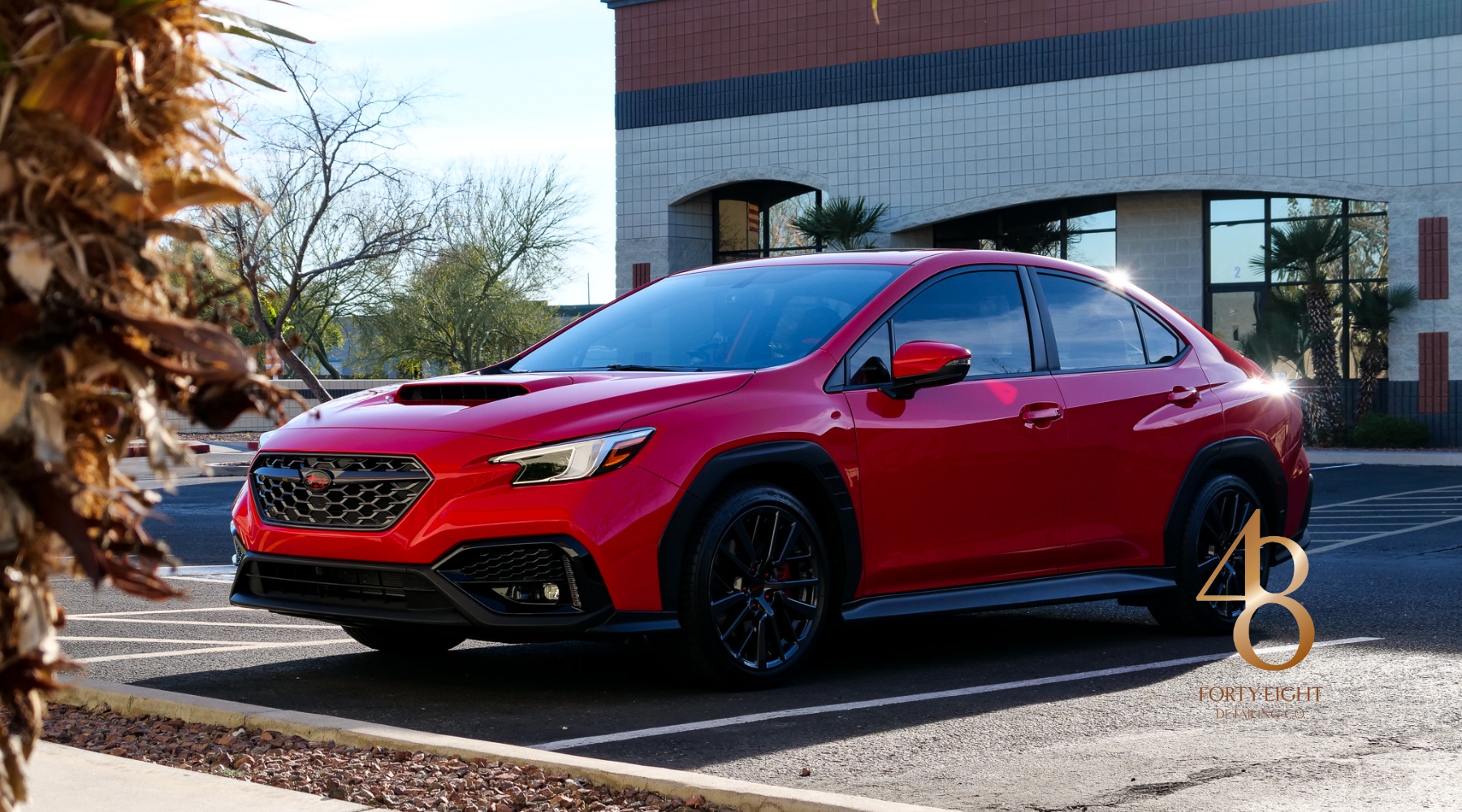Living in Arizona means dealing with relentless sunshine, intense heat, and year-round UV exposure. If you’re a vehicle owner in Surprise, AZ, or anywhere across the Grand Canyon State, you’ve likely considered window tinting, not just for style, but for protection, privacy, and comfort. But one crucial question arises: What window tint percentage works best in Arizona?
In this guide, we’ll explore the ideal window tint percentage for Arizona drivers, helping you balance legal compliance, heat rejection, visibility, and aesthetics. We’ll also break down Arizona’s tint laws, explain your options, and share tips from the experts at 48 Detailing, your trusted local pros for ceramic window tint installation.
Understanding Arizona's Legal Window Tint Limits
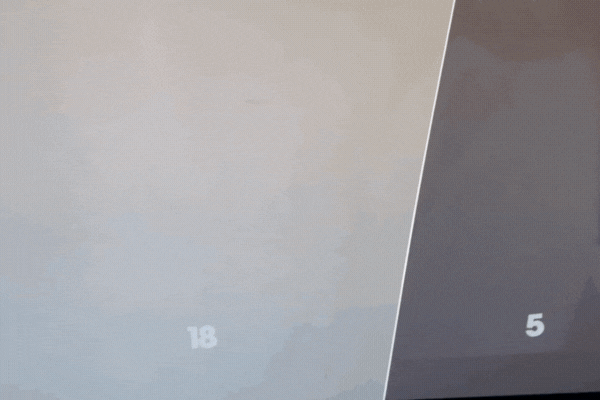
Before you choose a window tint percentage, it’s important to understand how Arizona’s laws regulate window tinting, especially through a metric called Visible Light Transmission (VLT).
What Is VLT in Window Tint?
VLT (Visible Light Transmission) refers to the percentage of visible light that can pass through your car’s window glass and tint film combined. The lower the VLT, the darker the tint.
Here’s how common percentages compare:
- 70% VLT – Very light tint, barely noticeable, excellent visibility day and night
- 35% VLT – Medium-dark tint, balanced privacy and light transmission
- 20% VLT – Darker appearance, noticeable reduction in visibility, especially at night
- 5% VLT – Very dark or “limo tint,” offers maximum privacy but may impair visibility at night
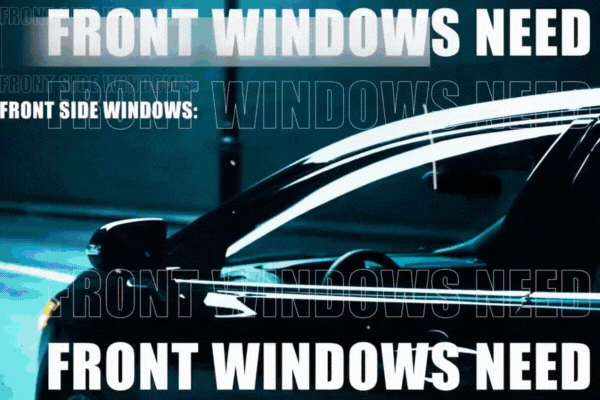
Legal Window Tint Percentages in Arizona
According to current Arizona window tint laws, here’s what’s permitted:
- Front Side Windows: Must allow 33% or more VLT (meaning they must let at least 33% of visible light pass through).
- Back Side Windows & Rear Window: Any darkness is allowed for VLT. However, if the rear window is tinted, your vehicle must have dual side mirrors, and tint must still follow the 35% reflectivity limit.
- Windshield: Only non-reflective tint is allowed above the AS-1 line (top ~5 inches)
- Reflectivity: Up to 35% reflectiveness allowed
Arizona also limits how shiny your tint can be. Tint films can’t exceed 35% reflectiveness, which means mirrored or highly metallic-looking films aren’t legal. This prevents glare for other drivers and ensures your tint stays compliant. - Medical Exemptions: Permitted for individuals with qualifying conditions (more on this below)
Disclaimer: Window tint laws can change and may vary based on local enforcement practices. Always consult with a professional installer or check with the Arizona Department of Transportation to ensure your vehicle remains compliant with current regulations.
Choosing the Right Window Tint Percentage in Arizona
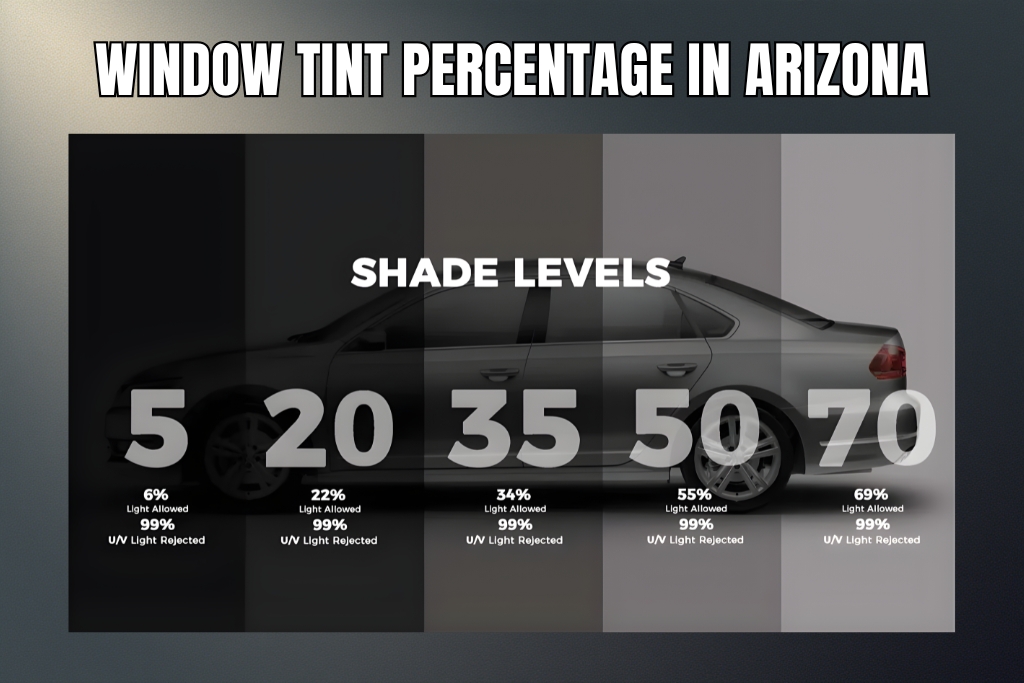
With legal boundaries in mind, what window tint percentage is ideal for comfort, style, and compliance in Arizona’s climate?
Let’s look at common options.
Popular Tint Percentages and Their Pros & Cons
70% VLT – Lightest Tint
- Pros: Excellent visibility, especially at night; legal on all windows; high UV protection
- Cons: Minimal heat rejection or privacy
35% VLT – Medium Tint
- Pros: Balanced heat reduction, style, and visibility; compliant for front side windows
- Cons: Not as private as darker tints
20% VLT – Dark Tint
- Pros: Enhanced heat and UV rejection; better privacy; great for rear windows
- Cons: Not legal for front windows; moderate impact on night visibility
5% VLT – Very Dark Tint (“Limo Tint”)
- Pros: Maximum privacy and heat blocking
- Cons: Illegal on front windows in AZ; significantly reduces night visibility
To get the best of both worlds, many drivers opt for 35% VLT on front windows and 20% or 5% on rear windows, especially when using advanced materials like ceramic window tint.
Ceramic Tint: A Smart Choice for Arizona Drivers
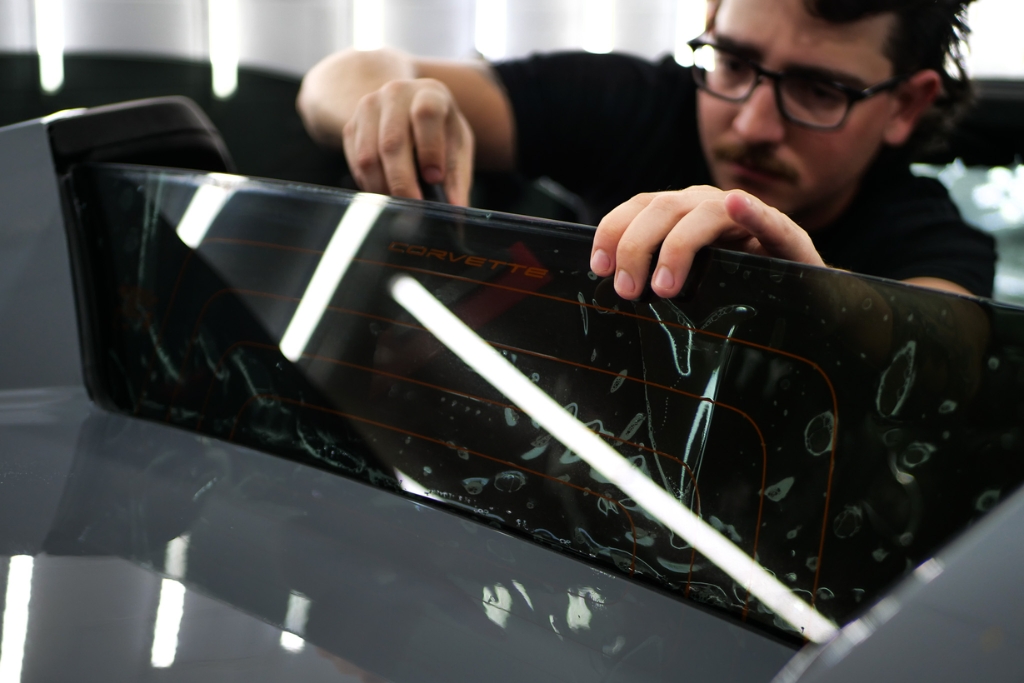
At 48 Detailing in Surprise, AZ, we recommend ceramic window tint for its superior performance, especially under Arizona’s intense sun. Unlike standard dyed films, ceramic tint blocks up to 99% of UV rays and up to 96% of infrared heat, offering advanced protection no matter the shade.
This means you can select a lighter window tint percentage for better visibility while still benefiting from exceptional heat rejection and skin protection. For example:
- 35% VLT ceramic film provides strong heat reduction and legal compliance for front windows
- 70% VLT ceramic tint is ideal for drivers who prioritize visibility without compromising on UV defense
Ceramic tint also:
- Minimizes interior fading by blocking UV damage to upholstery and dashboards
- Reduces sun glare, improving safety during sunrise and sunset drives
- It is non-metallic, so it won’t interfere with GPS, radio, or cell signals
- Comes with lifetime warranties for peace of mind
Whether you’re battling scorching summer temps or just want added comfort and protection, ceramic tint is an investment in both performance and longevity. Discover how ceramic tint enhances heat rejection and UV protection in our in-depth guide.
Factors to Consider When Choosing Your Tint Percentage
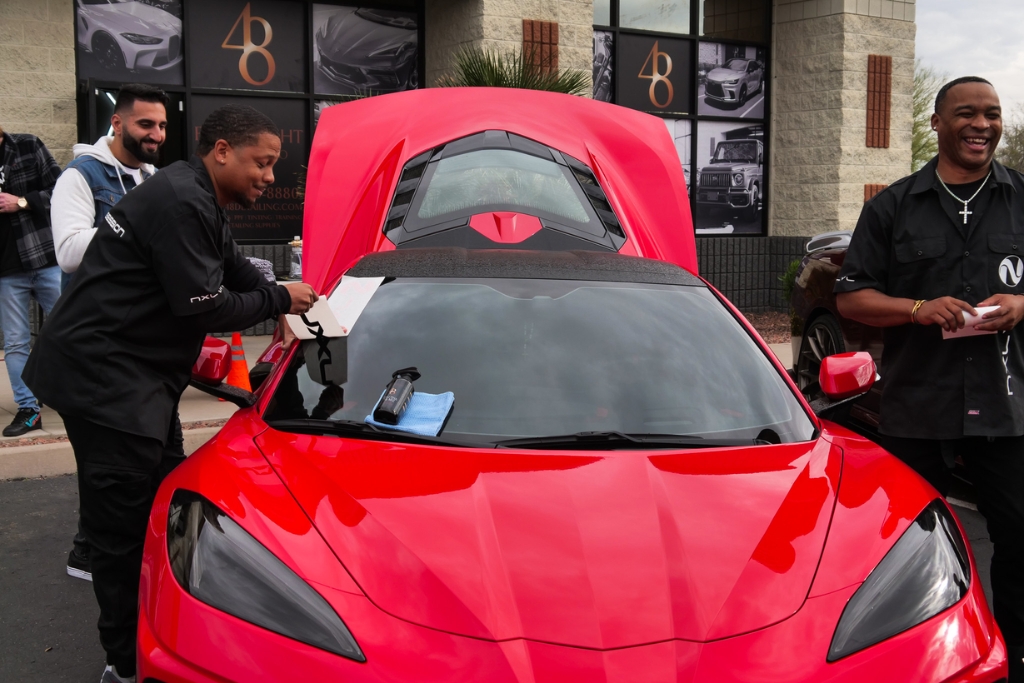
1. Driving Conditions
- Daytime Drivers: If you’re on the road frequently during the heat of the day, a darker tint (like 20%–35% VLT) helps reduce glare, interior heat, and sun damage.
- Night Drivers: Lighter tints (such as 50%–70% VLT) offer clearer visibility during low-light conditions, reducing the risk of accidents caused by limited vision.
2. Vehicle Use
- Family Cars: Parents often prefer darker rear window tints (20% VLT or lower) to provide shade, comfort, and privacy for children.
- Daily Commuters or Rideshare Drivers: A legal, lighter tint (35%–50% VLT) ensures compliance and maintains visibility, especially in traffic or urban settings.
- Commercial/Work Vehicles: Balance utility and aesthetics, especially if you’re transporting equipment or using the vehicle for client visits.
3. Aesthetic Preferences
- Darker Films: Provide a sleek, luxury-style appearance and enhanced privacy, popular for sports and high-end vehicles.
- Lighter Films: Blend more naturally with factory glass, delivering a clean, understated look while still offering UV protection.
4. Medical Needs
- Arizona allows medical exemptions to standard tint laws for drivers with conditions such as lupus, melanoma, or albinism that require additional UV protection.
- The process involves submitting a completed medical exemption form, signed by a licensed physician, to the Arizona Department of Transportation.
- If approved, you can legally apply a darker VLT film than normally allowed on front windows.
- Explore medical tint exemptions here.
Why Work with 48 Detailing?
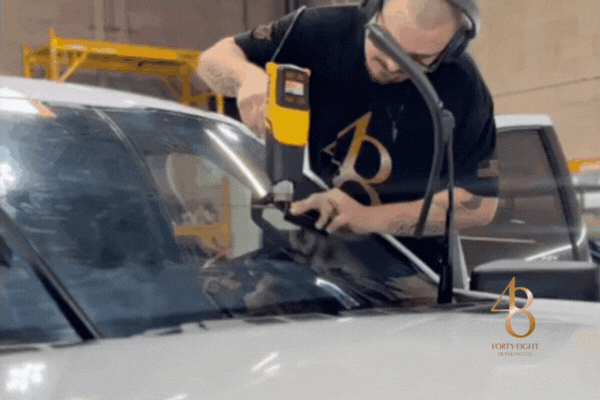
At 48 Detailing in Surprise, AZ, we’re not just another tint shop; we’re automotive protection specialists with a reputation for quality, precision, and customer care. Our professional window tinting service elevates both the look and performance of your vehicle.
We offer:
- Certified ceramic film options in 5%, 15%, 35%, 50%, and 70% VLT to match your legal and lifestyle needs
- Expert, bubble-free installations performed in a clean, climate-controlled environment
- Advanced UV, infrared, and heat rejection up to 99% to keep your interior cool and protected
- Lifetime warranties on all tint films, giving you peace of mind for the long haul
- Personalized consultations to help you select the ideal window tint percentage for your driving habits, aesthetic preferences, and Arizona’s legal requirements
Our goal is to help you drive more comfortably, safely, and stylishly. Whether you’re enhancing your vehicle’s appearance, reducing interior temperatures, or adding long-term UV protection, 48 Detailing delivers results you can see and feel.
Plus, we also specialize in paint protection film, ceramic coatings, and auto detailing, making us your one-stop shop for vehicle preservation and enhancement.
Finding the Best Tint Percentage in Arizona
Choosing the best window tint percentage in Arizona comes down to your priorities, compliance, comfort, privacy, and visibility. Given the state’s strict laws and intense heat, the right balance is key.
Most Arizona drivers benefit from:
- 35% VLT on front windows: A smart, legal choice that offers style, UV protection, and clear visibility
- 20% or 5% VLT on rear windows: Ideal for maximum heat rejection and privacy, especially for passengers or valuables
- Ceramic window tint: The best of both worlds, high performance without needing to go darker, making it perfect for drivers who want comfort and clarity
Ultimately, your vehicle, daily routine, and personal style all factor into the decision. That’s why working with a trusted expert matters.
Ready to upgrade your driving experience? Contact 48 Detailing in Surprise, AZ, for professional tinting and automotive protection services. We’ll help you find the perfect solution for Arizona’s climate and your lifestyle.
Arizona-Specific FAQs About Window Tint Percentage
What is the darkest legal tint in Arizona?
For front side windows, the darkest legal tint is 33% VLT. Rear windows can be darker, provided your vehicle has dual side mirrors.
Is a 20% tint legal in Arizona?
Only on rear windows. It’s too dark for front side windows under Arizona law.
Is 5% tint legal?
No for front windows, yes for rear windows if side mirrors are present.
What's the advantage of 33% VLT tint?
It’s the legal limit for front windows, offering decent heat rejection, good visibility, and reduced risk of citations, a smart balance for Arizona drivers.
Why is reflectivity important?
Reflective films reduce glare and further reject heat, but Arizona limits reflectivity to 35% to ensure safety.
What about nighttime driving?
Darker tints can seriously reduce visibility at night, especially on rural roads or poorly lit areas. Choose a VLT of 35%–70% if you drive frequently at night.
Do I need proof of tint specs?
Yes, always keep your tint installation invoice and film specs in your glovebox. If pulled over, this documentation can verify your compliance with Arizona’s tint laws.

